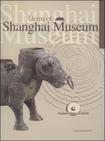上海博物馆珍品
2007-1
人民教育出版社
陈燮君 主编
291
无
Founded in 1952, the Shanghai Museum holds for China and the world agrand collection of history, art and antiquities from ancient and livingcultures. The Shanghai Museum was allocated to the current site People'sAvenue 201 by the Shanghai Municipal Government in 1993 and reopenedto the public in 1996. Erected at the center of the People's Square,the Shanghai Museum, together with the Shanghai Grand Theatre, theCity Hall, and the Shanghai City Planning Museum, makes an impressiveskyline of the metropolis and contributes to its cultural and economiclife.Designed in a round-cover-and-square-body style, its building embodiesthe traditional Chinese concept of "the heaven is round and the earth issquare". With an area of 39,200 square meters and a height of 29.5 meters,the Shanghai Museum has 10 permanent galleries and 3 temporary exhibitionhalls. Since its foundation, the Shanghai Museum has been committingto conserving, protecting, restoring, authenticating and developingChina's national culture and art treasures. Its collection continues togrow and now houses over one million works, among which 120,000 areof high value. Through five thousand years of ancient China's brilliantcivilization, its magnificent works cover about 21 types, including bronzes,ceramics, calligraphy, painting, jade, ivories, bamboo and wood wares,lacquered wares, oracle bones, seals, coins, furniture, etc. Its bronzes,ceramics, painting and calligraphy collections are among the most comprehensiveand finest in the world. One of the latest and the most notableadditions to its collection is the Chunhua Ge Tie (a calligraphy robbingcollection) purchased in 2003.
The Shanghai Museum became a must-go landmark for its international standing and its key role in the display of our nation’s cultural heritage.In recent years,over 1 million people visit the Shanghai Museum every year and about half of them are foreigners.We are obliged to make the appreciation of the valuable collections possible to the great number of people from china and all over the world.In order to promote universal understanding of our collections and the culture behind them,we have been longing to introduce the Shanghai Museum in languages besides Chinese.
Ancient Chinese Bronze GalleryA History of Ancient Chinese BronzeInitial Stage(3),Developing Stage (3),Zenith Stage(3),Transition Sage(4),Renewal Stage(4)Classifications of BronzesFood VesselsCooking Vessels:Ding (6), Li (6), Yan (6)Food Containers:Gui (6), Xu (7). Dui (7), Dou (7)Wine VesselsDrinking Vessels:Jue (7). Jia (8). Gu (8), Zhi (8)Wine Containers:Hu (8), You (9). Zun (9), Lei (9),Ling (9), Pou (9), Gong (10),Square Yi (10)Wuter Vessels: Pan (10), He (10), Yi (11), Jian (11)Musical hzstruments: Nao (11), Zhong (11), Drum (12)Weapons and Others: Yue (12), Jian (12), Sheng (12),Btvnze Pillow (13),Cowrie Container (13),Btvnze Mirror (13)Decorations on the BronzeAnimal Musk Design (14),Dragon Desitcn (14),PhoenLr Design (14), Animal Design (15),Metamorphosed Animal Design (15),Geometric Design (15), Puinting Design (16)Casting TechniquesPiece-mold Method (17), Lost-wax Methnd(18)Dcrcrativc Craft, manshipAncient Chinese Sculpture GalleryA History of Ancient Chinese SculptureBuddha Figure SculpturesAncient Chinese Ceramics GalleryA History of Chinese CeramicsFamous Kilns in Ancient TimesMajor Types of CeramicsAncient Chinese Painting GalleryA History of Ancient Chinese PaintingMajor Types of Traditional Chinese PaintingAncient Chinese Calligraphy GalleryA History of Chinese CalligraphyMajor Types of Chinese CalligraphyAncient Chinese Seal GalleryA History of Ancient Chinese SealsChinese Ming and Qing Furniture GalleryChinese Ming and Qing FurnitureAncient Chinese Jades GalleryA History of Ancient Chinese JadesChinese Minority Nationalities' Art GalleryCraft of Chinese Minority NationalitiesAncient Chinese Coins GalleryA History of Ancient Chinese CoinsAppendix Ⅰ:Articles IncludedAppendix Ⅱ:Table of Chinese Dynasties
插图:Initial StageBronze, an alloy of copper, till and lead, can be used to fashion ritualvessels, tools and weapons. The arrival of bronze heralded a new age inthe history of China. The era of the Shang and the Zhou dynasties isgenerally known as the Bronze Age of China.Eriitou Culture marks the beginning of Chinese bronze casting, whichdated from 5,000 years ago. The range of types of vessel cast was quitebroad, including containers, musical instruments, weapons, tools andpersonal ornaments. Ruins of foundries were also found at the site.In China, as in other societies, rituals carried a very important socialfunction in generating social cohesion and in ruling the state. Ritualbronzes of this period were thin-walled and cast by mature techniques.Developing StageDuring the early and middle Shang Dynasty (16th-13th century B.C.),bronze casting became a major state industry. Ritual vessels producedthen were mainly wine containers. A feature common to this period'sbronzes was their relatively thin walls. Decoration trended towards morebold and complex, and the most popular motif was the animal-mask. Themold-making process became sophisticated and an ingenious techniquewas developed for casting a complicated shape in a sequence of separatepouring of metal. The progress laid a solid foundation for the comingzenith of the bronze art.
《上海博物馆珍品》由人民教育出版社出版。

无
光盘内容对我来说浅了点,这本英文书准备给宝宝学英语用。